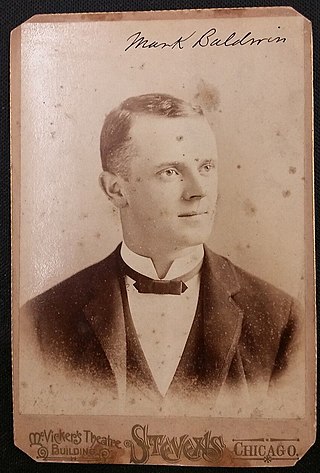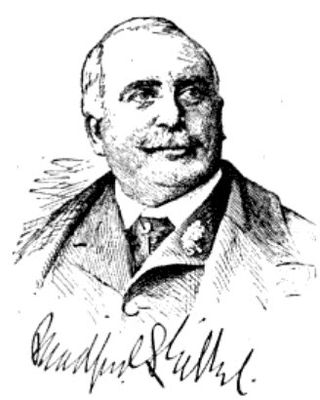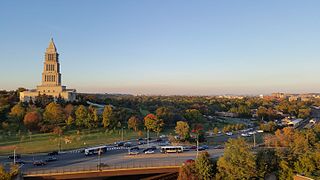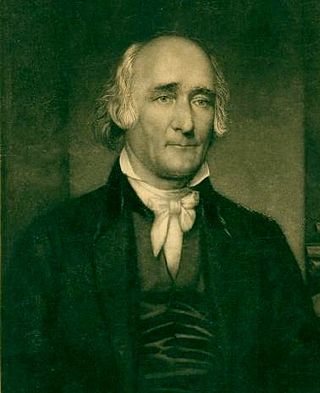
Richard Parker was a nineteenth-century politician, lawyer, and judge from Virginia.

James Edwin Campbell was an American educator, school administrator, newspaper editor, poet, and essayist. Campbell was the first principal of the West Virginia Colored Institute from 1892 until 1894, and is considered by the university as its first president.

Marcus Elmore Baldwin, nicknamed "Fido" and "Baldy", was an American right-handed professional baseball pitcher who played seven seasons in Major League Baseball (MLB). In 346 career games, he pitched to a 154–165 win–loss record with 295 complete games. Baldwin set the single-season MLB wild pitches record with 83 that still stands today.

The Southern Intercollegiate Athletic Association (SIAA) was one of the first collegiate athletic conferences in the United States. Twenty-seven of the current Division I FBS football programs were members of this conference at some point, as were at least 19 other schools. Every member of the current Southeastern Conference except Arkansas and Missouri, as well as six of the 15 current members of the Atlantic Coast Conference plus future SEC member University of Texas at Austin, currently of the Big 12 Conference, formerly held membership in the SIAA.

Bradford Lee Gilbert was a nationally active American architect based in New York City. He is known for designing the Tower Building in 1889, the first steel-framed building anywhere and the first skyscraper in New York City. This technique was soon copied across the United States. He also designed Atlanta's Cotton States and International Exposition of 1895, the Flatiron Building in Atlanta, and many railroad stations.

Sir Joseph Palmer Abbott, was an Australian politician, pastoralist and solicitor.

Charles Creighton Carlin was an American lawyer, newspaper publisher and Democratic politician who served in the United States House of Representatives representing Virginia's 8th congressional district.
John Peyton Garnett Nelson was an American college football coach and physician. He served as the head football coach at Richmond College—now known as the University of Richmond—in Richmond, Virginia, for one season, in 1901, compiling a record of 1–7.

Richard "Bill" Armstrong was an American college football player and coach. He served as the head football coach at the College of William & Mary in 1896, the United States Naval Academy from 1897 to 1899 and the Hampton Institute—now known as Hampton University—in 1912, compiling a career college football coaching record of 24–8. At the Naval Academy, Armstrong also coached rowing from 1897 to 1899.

Alexandria is an independent city in the northern region of the Commonwealth of Virginia, United States. It lies on the western bank of the Potomac River approximately 7 miles (11 km) south of downtown Washington, D.C. Alexandria is the third-largest "principal city" of the Washington metropolitan area which is part of the larger Washington-Baltimore combined statistical area.

Benjamin Hallowell was the first president of the Maryland Agricultural College.
The following is a timeline of the history of the city of Alexandria, Virginia, USA.
Sarah A. Gray was an American educator from the state of Virginia.
The Duluth, Missabe and Northern Railway (DM&N) was a railroad company in the U.S. state of Minnesota. It was one of the earliest iron ore hauling railroads of the area, said to have built the largest iron ore docks in the world, and later was one of the constituent railroads in the merger that formed the Duluth, Missabe and Iron Range Railway.

Dr Elizabeth Pace was a Scottish doctor, suffragist and advocate for women's health and women's rights.
Charles Edgar Buckeridge was an English church decorative artist and the son of Charles Buckeridge, a Gothic Revival architect.
Hallowell School for Girls was the first public school for African American girls in Alexandria, Virginia.

Eppa Hunton III, known as Eppa Hunton Jr., was an American attorney. The son of General Eppa Hunton, he experienced a turbulent childhood with the American Civil War and Reconstruction as its backdrop. After graduating from the University of Virginia School of Law, he practiced law with his father in Warrenton, Virginia, for a number of years before moving south to Richmond in 1901 to help found the law firm Munford, Hunton, Williams & Anderson.












